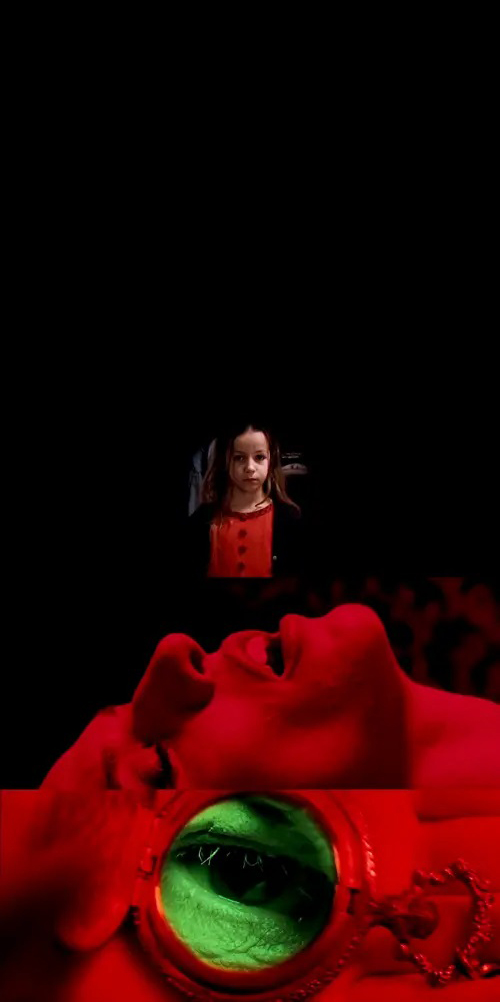
Table of Contents
-
Mika Ninagawa: Lavish Excess — a video Essay by Aaron M. Kerner
-
Arachnophobia — a film by Pavel Koshukov
-
Traveling While Standing Still — a photo and commentary by Daniel Miramontes
-
Layers — a film by Anthonia Okyejekwe
-
Necessary Distraxion — an essay by Luke Safely
-
1+1= — a film by Natalya Sharapova
-
D is for Distraction — an essay by Andrew William White
Mika Ninagawa: Lavish Excess
A Video Essay by Aaron M. Kerner
Abstract
Excess might be another form of distraction. Excess in this video essay refers to those cinematic elements that fall outside narrative meaning/content—namely, aesthetic embellishments. And these embellishments, which are typically addressed to the body of the spectator, very well might distract from the narrative content.
“Mika Ninagawa: Lavish Excess” focuses on Ninagawa’s films, and the ways she peddles in the currency of excess. Additionally, the mobilization of the term “excess” is a deliberate effort to recalibrate recent scholarship on extreme cinema. This is an effort to retain the momentum in recent scholarship, while hoping to lay claim to greater autonomy in defining what the cinema of excess might look like.
Bio

Aaron Kerner is a Professor in the School of Cinema at San Francisco State University. He published Film and the Holocaust (Continuum, 2011) — an extensive survey of cinematic treatments of the Holocaust. In 2015, Rutgers University Press published his volume Torture Porn in the Wake of 9/11. His co-authored book Extreme Cinema (Edinburgh University Press) was released in 2016.
Arachnophobia

A Film by Pavel Koshukov
Abstract
Our dreams and nightmares are difficult to recall, and it almost seems as if there is an overabundance of information being presented by our subconscious. The dream format, then, matches Walter Benjamin’s notion of distraction as a basic element of cinema, whereby viewers are overstimulated by the scattered rush of images rather than focusing their attention on a singular object. Arachnophobia presents a dream as a series of images placed over a larger image. The quick succession and abstract nature of the images gives an impression to the viewer of what the nightmare is about, but not a clear definition. It could be said that the visual experiences of a dreamer are close to watching a cinema of distraction.
Bio
Pavel Koshukov received a Bachelor of Arts in Film Production at the California State University of Sacramento in 2015. Currently working on a Master of Arts in Cinema Studies at the San Francisco State University. Interested in incorporating old genre film iconography with new digital technologies in order to highlight the aesthetic appeal of retro popular cinema.
Traveling While Standing Still

Photo by Daniel Miramontes, 2017
Commentary by Daniel Miramontes
There is a dimming down of consciousness, a sort of myopic attention. A head-down society is simply a symptom of a skewed way of seeing life. Social media not only drains our devices, it drains our humanity as well. It replaces those necessary parts of being human, turning them into data, into profiles, into “interactions” without contact. The curated representations of ourselves on social media have been manufactured to create a facade behind which lie only other facades. As David Foster Wallace put it, “Hip cynical transcendence of sentiment is really some kind of fear of being really human . . . since to be really human . . . is probably to be unavoidably sentimental and naive and goo-prone and generally pathetic.”
These representations overlook the hidden parts of the psyche: the micro-expressions, body language, scents, tastes, and “goo-prone” touches that you only get from face-to-face encounters. These are parts of life that cannot be translated to data, turned into emoji.
While social media do facilitate access to a new world of information and interactions, at the same time they provide an easy entrance to globalization and commodification. Traveling while standing still, the feeling is that we can go anywhere and consume anything. In other words, never fully being part of anything, you’re neither here nor there. The abundance of Things and the overload of information–created by the western idea of progress–becomes an incessant noise, making it impossible to live in the now. The endless scrolling, tweeting, and chasing after the latest post or the latest gadget never stops.
As Slavoj Žižek observes, this situation is like drinking diet coke; people pursue the promise of this artificial thing even if it is just a representation, an idea of the real thing, which can never be fulfilled. They “drink the nothingness itself . . . in effect merely an envelope of a void” (Žižek). Following the latest smiley-face emoji is like being on a fast food diet, since fast food is only a representation of nutritious food. Like feeding on something of no substance, these hollow, modified versions of feelings and social interactions come to replace humanity as we know it. Ultimately, this hollow diet can only lead to the formation of hollow people.
But in contrast to the postmodern nihilism that is embedded in so much of our popular culture, I believe that many people are already waking up from this diminished view of life. Groups of people are sprouting everywhere that are becoming more conscious; they are taking their eyes off their phones and looking into each other’s eyes and beginning this very important dialogue. The work has begun, acknowledging these aspects of the current system are steps forward in the right direction: “I do not pretend to understand the moral universe; the arc is a long one, my eye reaches but little ways; I cannot calculate the curve and complete the figure by the experience of sight; I can divine it by conscience. And from what I see I am sure it bends towards justice.” Theodore Parker
Bio
Daniel Miramontes is a student pursuing a Bachelor of Arts degree in Studio Art and Cinema at San Francisco State University. His interests include the writings of Alan Watts and Carl Jung in regards to consciousness, and the practical understanding of existential queries. His visual work stems from these topics.
Layers
A Film by Anthonia Onyejekwe
Abstract
Layers is an experimental hybrid using a strong narrative driven plot that has four frames of simultaneous action occurring on the screen. This short film has a similar approach to Mike Figgis’ Timecode (2000).
The element of distraction appears throughout this short film because it mixes multiple screens and complicated, layered narratives that are intertwined in the soundtrack and score. Viewers have the opportunity to focus on a story they find appealing and re-watch the other stories they’ve missed afterwards.

The characters in Layers experience significant trauma in their lives and learn how to cope through acceptance and the power of letting go. Each character deals with their unique issue in the privacy of their homes. However, outside their home, they conceal their problems with the mask of “normalcy.” Observing these psychological layers suggests that distraction can also refer to the ability to cope with complex and at times contradictory information at the same time.
Bio
Anthonia Onyejekwe is a Master of Fine Arts graduate from San Francisco State University. Recently, she produced and directed a documentary, titled She, about a black transgender woman who was banned from using a woman’s bathroom in Downtown San Francisco. Her film is currently being submitted to film festivals.
Necessary Distraxion: The Partial Pleasure Principle & the Virtuality Complex
An Essay by Luke Safely
Abstract
This paper takes a Lacanian approach towards spectators’ experience regarding distraction and pleasure within cinema. Slavoj Zizek’s interpassivity and Gilles Deleuze’s virtuality are expanded and applied to the relationship of distraction/pleasure and spectator experience, concentrating on the effects that it has on the future of cinema to come.
Bio
Luke Safely is currently a letter carrier with a little extra time to think about things during his deliveries. He recently graduated from Minnesota State University of Moorhead with a B.A. in Film Production and a minor in Philosophy. His interests include experimental film theory/production, phenomenology, psychoanalysis, and post-structuralism.

Abandoned House • Arena, ND • May 15, 2016 | Photograph by Lewis Ableidinger
Ruins of the Pleasureplex
Cinema, a space where one can live out their wildest fantasies and engage in their pleasures from the safety of their seat. No other previous form of art has captivated its spectator as strongly as cinema does to this day. Early cinema critics claim that this captivation is a plague of distractions that the spectator gleefully indulges in. The very thing that the audience is supposedly being distracted from by this imitation on the screen is the real. Cinema is therefore seen as nothing but an illusion, an accumulation of images projected at a certain speed, and if you were to put anything from the physical world next to this illusion, its captivating power would collapse and be lost. This illusionary distraction allows the audience to engage in their basic pleasures via the image and lose themselves to the real of the physical world, a new form of escapism to distract the masses from the injustices of their everyday lives.
Cinema has truly evolved since these early criticisms (it has even become an educational instrument for fighting injustice), and film criticism has developed into a serious field where things like gender, race, and sexuality are critically applied to cinema. Yet, even with these advancements, cinema is still often seen as a nothing more as an entertainment for the masses to indulge themselves. What is wrong with this though? It is only natural for us to want to satisfy our desires, especially when the toils of life constantly press against us; this indulgence is arguably necessary for our very sanity.
In his essay “Cult of Distraction,” Siegfried Kracauer criticized Berlin’s movie theaters for being “shrines to the cultivation of pleasure,” but with the evolution of cinema there was a shift in pleasure. The once grand pleasureplex has been abandoned and in its ruins is an entirely new distraction, a monstrosity that Kracauer could have not foreseen, the neglect of pleasure.
The Oratory of Desire
In the beginning of Sophie Fiennes’ documentary The Pervert’s Guide to Cinema (2006), Slavoj Žižek says, “Cinema is the ultimate pervert art. It doesn’t give you what you desire, it tells you how to desire.”
Throughout film’s history there have been many theories of how cinema reinforces or trains the spectator’s desire; in, for example, Laura Mulvey’s famous essay “Visual Pleasure and Narrative Cinema,” Mulvey uses psychoanalysis as a political weapon against Hollywood cinema’s reinforcement of a patriarchal system that dominates our culture. The representation of the female in cinema is nothing more than an object of desire for onlookers to derive pleasure from, a criticism guided by Mulvey’s reconceptualization of the Lacanian notion of the “gaze.” Mulvey argues that this system of pleasure must be destroyed by the radical transcension of pleasure through psychoanalytic means. Simply restructuring this system of pleasurable forms is not enough, which is why Mulvey argues for the importance of transcending this pleasure and creating an entirely “new language of desire.” Mulvey made a critical step forward in addressing the problem of desire in cinema, but sadly this concept has been twisted into exactly what Mulvey warned us of, a mere restructuring of pleasure.
With the public outcry against inadequate (or even nonexistent) representation in cinema, Hollywood has had to adapt to include underrepresented identities in their films and industry. One of the main issues that have arisen about these new identities in cinema is that they are generally written, played, directed, and produced by people who do not fall under these identities, inasmuch as the field continues to be dominated by a majority of white males. These criticisms are very important and should be addressed, but the underlying dilemma remains: that the system of cinematic pleasure and desire has only slightly shifted to play the part of progressive ideology. With this addition of identity to the equation, the spectator is allowed to become even more lost in the pleasure of cinema, but with the restructuring of this system of pleasure there has been a change from the active role of the spectator’s private desires in cinema towards a passive role of pleasure; this is the concept known as interpassivity.
The Plane of Substitution
In his essay “The Interpassive Subject,” Žižek discusses how canned laughter in television is not simply a trigger to tell us when to laugh. Even when we do not engage in this prompt to laugh, we still feel a great sense of satisfaction from having experienced it. Žižek claims that this satisfication is the result of the Lacanian idea of “decenterment.” As spectators, we do not have to engage in this activity ourselves in order to gain a sense of pleasure through the action of the Other. Žižek argues that some will say that these feelings are false, but yet we have a sense of enjoyment that still appears true to us. The greatest thing that comes from this mode of substitution is the suspension of responsibility. Žižek uses the example of a husband who divorces his wife but still returns to her home and their children but who now finds a greater enjoyment in the time spent with them because he does not have the pressure and responsibility to the family as he did in the past. The issue that arises with interpassivity is that this relief of responsibility is only just that; the emotions that are expressed by the Other are not the spectator’s emotions and will never be. What the spectator experiences from interpassivity is the “passive” pleasure of being relieved of the responsibility of experiencing these emotions, which the Other “experiences” in the spectator’s place.
Interpassivity does not, however, end at canned laughter or a musical score that is supposed to fill in the emotions; interpassivity can carry over to the characters within cinema as well. It is quite important in cinema for the spectator to identify with the characters; this is how the special connection between cinema and the spectator is formed. However, with interpassivity spectators use the characters in a film as a substitute for their own emotions and experiences. One of the main problems that arises from this is that spectators can simply suspend moments of pain or sadness in the film because they don’t need to carry the responsibility of these emotions. For example, when someone watches a film about the injustices of war, they can see the pain and suffering. but simply don’t need to carry those emotions after the film. Spectators can simply suspend this responsibility and continue on with their lives as if nothing happened. Of course, this isn’t always the case, but it is becoming more common as spectators engage more deeply in interpassivity. This liberation from responsibility is a great freedom to the spectator because unlike in the world outside of cinema, they don’t have a responsibility to the character in the film as they do to the people around them in their everyday life. In a sense, spectators gain pleasure vicariously, interpassively, by allowing emotions to be experienced for them. With the spectator’s engagement in interpassivity, the pleasure principle that drives them is pushed “beyond reality,” to the point of pure pleasure.
The pleasure principle is a Freudian concept that basically states that humans seek to maximize pleasure while minimizing pain. Freud states that the pleasure principle is kept in check by the reality principle, the idea that we must keep our passions at bay due to the pitfalls of primal gratification in society. With cinema, spectators do not have the distraction of society anymore; we can simply suspend the reality principle and indulge in instant gratification. In this mode of cinema, the spectator does not even have to worry about minimizing pain; they can rid themselves of pain altogether by detaching themselves from the Other when a painful experience may arise. This phenomenon is the partial pleasure principle.
The partial pleasure principle does not simply end within the theater itself; the cinema has trained us through repetition so that this principle transfers to our everyday activities outside of cinema. Take for example an individual who has watched a documentary on Netflix and then educates a friend on the dire issues involved. Now that they have reached the point where both are aware of these disasters, what do they do? Nothing. They simply tell more of their friends to watch this documentary on Netflix or simply carry on with their lives, feeling that they have done their part in this situation. The partial pleasure principle allows us to feel this sense of involvement and action merely through the watching of the documentary. We have substituted the experience and actions in the film for our own, yet we have never had to leave the comfort of our home. Interpassivity can even reach the point of absurdity where the spectator does not even have to watch the film anymore. For instance, has their ever been a film that you know that you should watch because it seems important and everyone is talking about it? Sadly, we may not have the time or resources to see the film, so we read reviews, summaries and opinions from acclaimed experts about the film. Now we can talk about the film and tell others our opinion of it as if it is our very own opinion. The conundrum that is apparent within this constant loop of substitution is that the subject becomes disillusioned by these new distractions that cause the spectator’s experiences and identity to be forever lost within the plane of substitution.
The Spectre in the Virtuality Complex
The spectator plays a vital role in the livelihood of cinema; what is this art without those who view and challenge it? The spectator is not entirely lost to cinema but has been replaced by a spectre that has no major influence on cinema anymore. Without the influence and experience of the spectator, cinema is thrown into a death cycle, in which cinema regurgitates the same material that the spectator has become accustomed to. The relationship of the spectator and the cinema is necessary and one cannot continue without the other. This relationship is very similar to Lacan’s Borromean Knot.
Lacan’s concept of the Borromean knot focused on the relationship between the Real, the Symbolic, and the Imaginary. This knot was visualized as three interlocking rings; the removal of one caused the collapse of the rest. Similarly, cinema itself breaks down into Lacan’s three realms: the image being projected (the Imaginary), the apparatus of cinema (the Symbolic), and the spectator (the Real). The Imaginary, the image being projected to us, is the ideal fantasy that we have invested in; the illusion that we the spectators believe in. The Symbolic is like a law or regulation that has control over the imaginary (the image), which is demonstrated through framing, shot sequences, implementations of the director’s vision and more. Lacan’s Real is something very different from the common understanding of the real: for Lacan the Real is something prior to the imaginary and the symbolic, something that resists representation. Thus, the spectator is something special within the realm of cinema, something that the Symbolic tries to control by manipulating the Imaginary in front of the spectator’s very eyes. Yet, the spectator is able to persist through these actions, driving cinema to push itself further and further in hopes of reaching the Real.

Cinema is losing its spectator. As mentioned earlier, the spectator does not even necessarily need to watch the film anymore because they can gain the experience of watching the film by substituting the experience of others who have watched the film as their own. Cinema has simply accepted this substitution for the spectator and has chosen to influence not through the means of its work but by simply buying more advertising, paying for reviews, hiring big names, networking and much more. This tendency, if unchecked, will continue to spiral out of control to the point that films will not even need to exist anymore; there will simply be a proxy cinema being watched by a surrogate spectator. This idea is not as ridiculous as it seems. For instance, the recent phenomenon of the movie Shazaam, supposedly starring the actor-comedian Sinbad, has become a major issue because it does not actually exist; however, many individuals claim to have seen it. How is this possible? This case can be seen as merely an extreme version of interpassivity. These “spectators” have unknowingly engaged in interpassivity by substituting other’s claims about this film for an actual experience that they have had. Cinema, in the interests of its own survival, must shake spectators from their distracted interpassivity and bring actualization back to the experience of cinema.
Gilles Deleuze stated that there are two forms of the real, the actual and the virtual. On a basic level the actual is concrete things while the virtual is those things that are not concrete but are nevertheless just as real as the concrete. Deleuze argues that there is a possible interaction with the virtual that is known as actualization. Interpassivity suspends actualization because the spectator does not engage with the virtuality of cinema anymore; they let the Other do it for them; the interaction is lost. Without this interactivity, cinema is left suspended in a virtual state that can no longer affect the spectator—or the actual more generally. Indeed, this is how Brian Massumi, drawing on Deleuze, defines affect: as the “simultaneous participation of the virtual in the actual and the actual in the virtual.” Cinema must reactivate this interaction, actualizing a new distraxion that will awaken spectators from their interpassive trance.
A New Distraxion
The “Cult of Distraction” involved a space where spectators could engage in their pleasures, but now the distraction of cinema has evolved into a distraction from the spectators’ pleasure itself. Interpassivity has freed the spectator from the responsibility of their pleasures but this substitution has disrupted the unique experience of cinema. This substitution has just become another form of repression for the spectator but as Zizek stated, cinema’s role is to teach us how to desire. A new distraxion must repress the distraction of repression.
Cinema needs to stop offering comfort-food films that require little attention and, increasingly, by allowing spectatorial “interactions” to take place through recordings, reviews, summaries, commentaries, and top-ten lists that increasingly substitute for actual engagement. Instead, the spectator and cinema should acknowledge the problematic nature of this interpassivity and push themselves deeper into this special relationship they have with one another. We can do this by making cinema into the event it once was. Spectators and Cinema should interact with each other directly by forming film societies, festivals, conventions, and special events that are not controlled by outside or elitist sources. Stop the privatizing of the cinema experience and embrace the shared, collective experience it has always been. A new distraxion is needed so that we may resist and survive in the world of distractions that we face today.
Works Cited
Kracauer, Siegfried. “Cult of Distraction.” The Mass Ornament. Comp. Thomas Y. Levin. Cambridge, Massachusetts: Harvard UP, n.d. 323-28. Print.
The Pervert’s Guide to Cinema. Dir. Sophie Fiennes. Perf. Slavoj Zizek. P Guide Ltd., 2006. DVD.
Massumi, Brian, Parables for the Virtual: Movement, Affect, Sensation. Durham, N.C.: Duke UP, 2002. Print.
Mulvey, Laura. “Visual Pleasures and Narrative Cinema.” Critical Visions in Film Theory: Classic and Contemporary Readings. Eds. Timothy Corrigan, Patricia White, and Meta Mazaj. Boston: Bedford/St. Martin’s, 2011. 715-25. Print.
Zizek, Slavoj. “The Interpassive Subject.” (1998): n. pag. Www.lacan.com. Web.
1 + 1 =
A Film by Natalya Sharapova

Abstract
We all seem to be experts on distraction. Still distraction continues to be a vague term with an ambiguous moral standing. Is distraction a value or a calamity? Are we distracted because the technology prompts us to be? Or are we distracted because we are too focused on ourselves and need to escape?
Distraction is usually demonized and treated as a loss or deficit, but what if distraction could seen as liberating? It is often liberating to watch a movie when we are required to read, or to read an email when we are supposed to be working: i.e., distraction allows us to escape from obligations that have been imposed on us or that we have imposed on ourselves.
From yet another perspective, distraction could be considered a powerful engine of contemporary culture—leading us to remix the incongruous and the incompatible just by virtue of our permanently divided attention.
“1+1=” explores the mechanism of how the meaning of an original piece is enriched by another unrelated narrative via our distracted perception. The main story is a comic melodrama based on a short story of Daniil Kharms. The additional narrative is an experimental piece loosely based on the “Prisoner’s dilemma”. The resulting multi-screen narrative builds on the ability of our unfocused selves to process information from multiple sources.
Bio
Natalya Sharapova is an M.F.A. candidate at San Francisco State University where she directs films and studies media theory. During the past 10 years, Natalya has directed experimental and narrative shorts, produced several multimedia exhibitions and edited the international cinema section at SEANCE film journal. Her work is inspired by the writings of Christian Metz and Sergei Eisenstein.